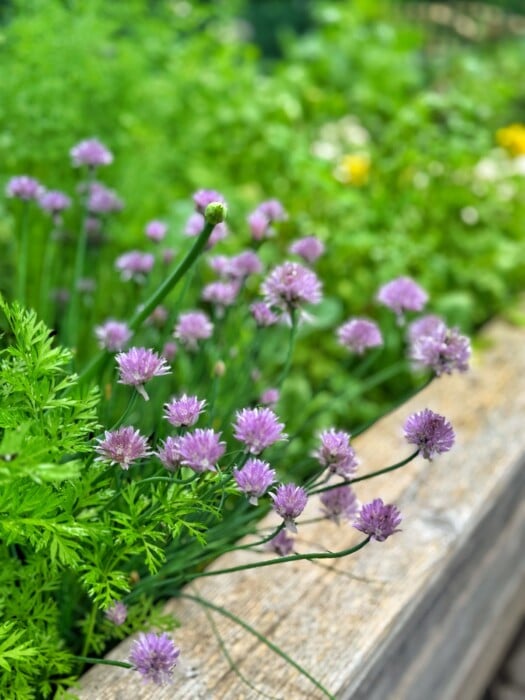Design a stunning potager garden! Blend flowers, herbs & veggies for a beautiful, productive kitchen garden. Grow food & enhance your landscape.
Are you dreaming of a garden that provides fresh, organic produce AND a adds touch of beauty to your outdoor space?
Creating a stunning potager garden allows you to blend beauty and functionality in your outdoor space, making sustainable living a reality. Potager gardens, also known as kitchen gardens, combine ornamental flowers with edible plants like vegetables, herbs, and fruits.
This guide will help you design an aesthetically pleasing and productive kitchen garden that enhances both your landscape and your lifestyle. Discover the benefits of edible landscaping and learn how to cultivate a thriving potager garden that supports organic and sustainable gardening practices.
(Posts on stacyling.com may contain affiliate links. Click HERE for full disclosure.)
What Exactly is a Potager Garden?
At its heart, a potager garden isn’t just a place to grow food; it’s a living work of art where beauty and productivity coexist in perfect harmony. Unlike a traditional vegetable patch tucked away in the back forty, a potager is designed to be admired, integrating seamlessly into your landscape as an extension of your home’s aesthetic.
More Than Just a Vegetable Patch: A Rich History
The concept of the potager (pronounced poe-tah-zhay) dates back centuries to the grand estates and monasteries of France. Here, gardeners didn’t just grow food; they cultivated edible landscapes that were as much about visual delight as they were about sustenance. Imagine strolling through a meticulously designed “garden room” where every plant, from the tallest artichoke to the smallest herb, played a role in a larger, beautiful composition. This isn’t just about rows of single crops; it’s about treating the garden as a curated space, a beautiful outdoor extension of your home.

Key Distinctions from a Traditional Vegetable Garden:
While both produce food, a potager stands apart with some key differences:
Beauty and Bounty Through the Seasons: The goal of a potager isn’t just a summer harvest. It’s designed for continuous beauty and productivity through multiple seasons. Which as you know is my jam! With careful planning, you can ensure there’s always something beautiful to look at and something delicious to pick, making your garden a year-round source of joy and sustenance.
Aesthetics Take Center Stage: In a potager, visual appeal is paramount, or at least equally important to the harvest. Instead of plain rows of single crops, you’ll find a delightful tapestry of diverse plant forms, colors, and textures, creating a feast for the eyes even before you gather your ingredients. Think of vibrant Swiss chard next to lacy carrots, all framed by fragrant herbs.
The Art of Intermingling: Forget rigid segregation! A defining characteristic of a potager is the deliberate blending of vegetables, herbs, fruits, and flowers. This intermingling isn’t just pretty; it fosters a healthier ecosystem, as many flowers attract beneficial pollinators and some herbs deter pests. It’s a vibrant, living mosaic.
| Aspect | Potager Garden | Vegetable Garden |
|---|---|---|
| Definition and Origin | A French-style garden combining ornamental and edible plants, focusing on aesthetics and productivity. | Primarily functional, focused on producing vegetables and herbs, often without decorative elements. |
| Design and Layout | Features symmetrical designs, decorative paths, and a mix of vegetables, herbs, fruits, and flowers. | Typically organized in rows or raised beds, prioritizing plant growth and ease of maintenance over aesthetics. |
| Purpose | Enhances landscape beauty while providing food. | Maximizes food production. |
| Maintenance | Requires ongoing attention to both plant health and visual appeal. | Focuses on crop care and harvesting. |
I’ve been growing a vegetable garden since Chris and I bought our first former family home over 23 years ago. Since moving here, the flavor of the property begs for a chic, elevated design. So I decided to transform the old basketball court into a potager garden with raised beds that I’ll tell you more about at then end of this post.


Top Benefits of Growing a Potager Garden
Growing a potager garden comes with numerous benefits, combining both practical and aesthetic advantages. Here’s what you need to know.
Fresh and Organic Homegrown Produce
With a potager garden, you have the opportunity to grow your own fresh and organic fruits, vegetables, and herbs in an aesthetically pleasing way. You have greater control over the cultivation methods where you can avoid harmful pesticides and harsh chemicals while ensuring the highest quality produce for you and your family.
And seriously, there is nothing better than walking out to your own garden to harvest herbs, vegetables, and fruits that you grew yourself. It is very self-satisfying and the harvest tastes far better than anything you can ever buy from the market.

Enhancing Your Kitchen Garden With Beauty and Aesthetics
A potager garden adds a touch of beauty and visual appeal to outdoor spaces. To me, it creates a garden room where one can enjoy the beauty while harvesting produce and flowers at the same time. The combination of flowering plants, juicy vegetables, and carefully planned layouts create a functional and picturesque garden that is pleasing to the eye.
Maximizing Edible Landscaping Space
Potager gardens are designed to maximize the use of space efficiently. By intermixing vegetables, herbs, and flowers, you can make the most of every inch of your garden. Vertical gardening techniques using trellises, obelisks, and arches help utilize vertical space, ideal for small yards or limited garden areas. So you can grow more things because you’ll increase your growing space.
Companion Planting in Your Potager Garden
Potager gardens employ companion planting techniques, which involve planting certain plants together to maximize their growth potential and cut down on the use of pesticides. This practice promotes biodiversity, attracts beneficial insects, deters pests, and improves overall plant health and productivity. (More on this technique below).

Potager Gardens Are Pollinator-Friendly
Including flowering plants in your potager garden attracts pollinators like bees, butterflies, and hummingbirds. These pollinators play a crucial role in the reproduction of plants, increasing fruit and vegetable yields and ensuring a healthy ecosystem.
Have you ever seen your summer squash or zucchini flower but not fruit? That happens because the male and female flowers didn’t pollinate. So creating a habitat that invites more pollinators into your garden will help you get a better harvest from your garden. You can even let some herbs that start to bolt go to seed and flower to attract the pollinators. I just did this with my dill and cilantro that started bolting. It’s great for pollinators but also looks pretty in the garden too.

Growing a Potager Garden is an Educational Opportunity
A potager garden provides an excellent opportunity for learning and education, especially for children. It teaches them about the natural world, the importance of growing their own food, and instills a sense of responsibility and connection with nature. I’ve been gardening for well over 25 years and I still feel like I learn something new from growing things every day. It’s such a fun and rewarding experience to be able to grow your own food. And to be able to blend them with beautiful flowers too? Priceless.

Sustainable Gardening That Reduces Food Miles and Waste
By growing your own produce, you contribute to reducing food miles—the distance food travels from farm to plate. This reduces carbon emissions associated with transportation and helps to promote sustainability.
Additionally, having a potager garden allows you to utilize more food scraps and plant waste for composting, reducing household waste, and creating nutrient-rich soil for your garden.
Growing a Potager Garden is Therapeutic and Stress-Relieving
Gardening, including tending to a potager garden, has therapeutic benefits. It provides an opportunity to connect with nature, relieve stress, and enjoy the calming effects of being outdoors.
Gardening can be a mindful and rewarding activity, allowing you to escape the hustle and bustle of daily life. There is something very peaceful about digging in the dirt and tending your garden.

Planning a Potager Garden
When planning a potager garden, careful consideration is given to the arrangement and intermingling of different plants, creating a visually pleasing and harmonious design. Flowers, herbs, vegetables, and fruits are all thoughtfully integrated, resulting in a space that not only provides a bountiful harvest but also enchants the senses with its colors, scents, and textures.
A potager garden is not only a source of nourishment but also a place of tranquility and beauty, inviting you to immerse yourself in the joy of gardening and savor the rewards of a well-designed and productive space. Here’s how to get started.
Choose the Right Location for Your Kitchen Garden
Find a sunny spot in your yard that receives at least six hours of direct sunlight each day. This will ensure your plants receive the necessary light to grow and thrive as most vegetables, fruit, and herbs need full sun.
Choose a location with ample sunlight, as most vegetables and many herbs and flowers require at least 6-8 hours of direct sunlight daily. Consider proximity to your kitchen for convenience, but ensure the spot gets continuous sun from morning to evening. Avoid areas shaded by trees or buildings as they can limit the growth potential of your garden
Equally important, is siting your potager near a water source. Because trust me when I tell you that you want to make it easy on you to water in the dead heat of summer. It is NO FUN dragging around a heavy 100-foot hose. So really think the location through before siting your sustainable garden.

Enhancing Soil Quality and Soil Testing
Good soil is the foundation of a successful potager garden. Aim for well-draining soil rich in organic matter. Before planting, conduct a soil test to determine its pH and nutrient levels. Many extension services offer soil testing services. Based on the results, amend the soil with compost or other organic matter to improve its fertility and structure.
Preparing Your Garden For Edible Landscaping
Begin by clearing the area of any weeds, rocks, and debris. If the soil is compacted, till it lightly to a depth of about 6-8 inches. Avoid over-tilling, as it can damage the soil structure. Incorporate organic matter like compost or aged manure into the soil to enhance its fertility and water-holding capacity. Raised beds can be beneficial in improving drainage and making soil management easier.

Pre-Planning the Potager Garden Layout
Draw a detailed plan of your garden on graph paper. Mark the locations of raised beds, pathways, and any garden structures like trellises or arches. Make sure there is enough room for you to move a wheelbarrow or garden cart around so you can haul garden supplies around the beds with ease. Include features like compost bins and water sources.
When laying out your kitchen garden, consider crop rotation and companion planting in your layout to maximize space and improve plant health. It’s a good idea to rotate crops each year to maintain soil health and reduce pest and disease buildup. For example, follow heavy feeders like tomatoes with legumes that fix nitrogen in the soil.
Plan for succession planting to ensure continuous harvests throughout the growing season. And finally, think about incorporating geometric patterns or symmetrical layouts for a visually appealing design.
Designing Your Dream Kitchen Garden: Where Beauty Meets Bountiful Harvests
Now that you understand the essence of a potager garden, let’s delve into the exciting part: designing your own edible masterpiece. Creating a potager is an artful blend of thoughtful planning and creative planting, transforming your garden into a truly enchanting and productive space.
1. Laying the Foundation: Potager Garden Structure and Layout
The backbone of any beautiful potager lies in its structure. Think of it as creating an inviting outdoor room where every element serves a purpose.
Define Your Space with Enclosures
Just like walls define a room, enclosures give your potager a sense of intimacy and order. Consider using:
- Hedges: Low hedges of classic boxwood, fragrant lavender, or even edible shrubs like currants can create elegant borders.
- Fences: Ornamental fences, picket fences, or even simple trellises can frame the garden and provide vertical growing opportunities.
- Low Walls: Stone or brick walls add a rustic charm and can also serve as seating. These enclosures not only enhance beauty but also help protect your plants.
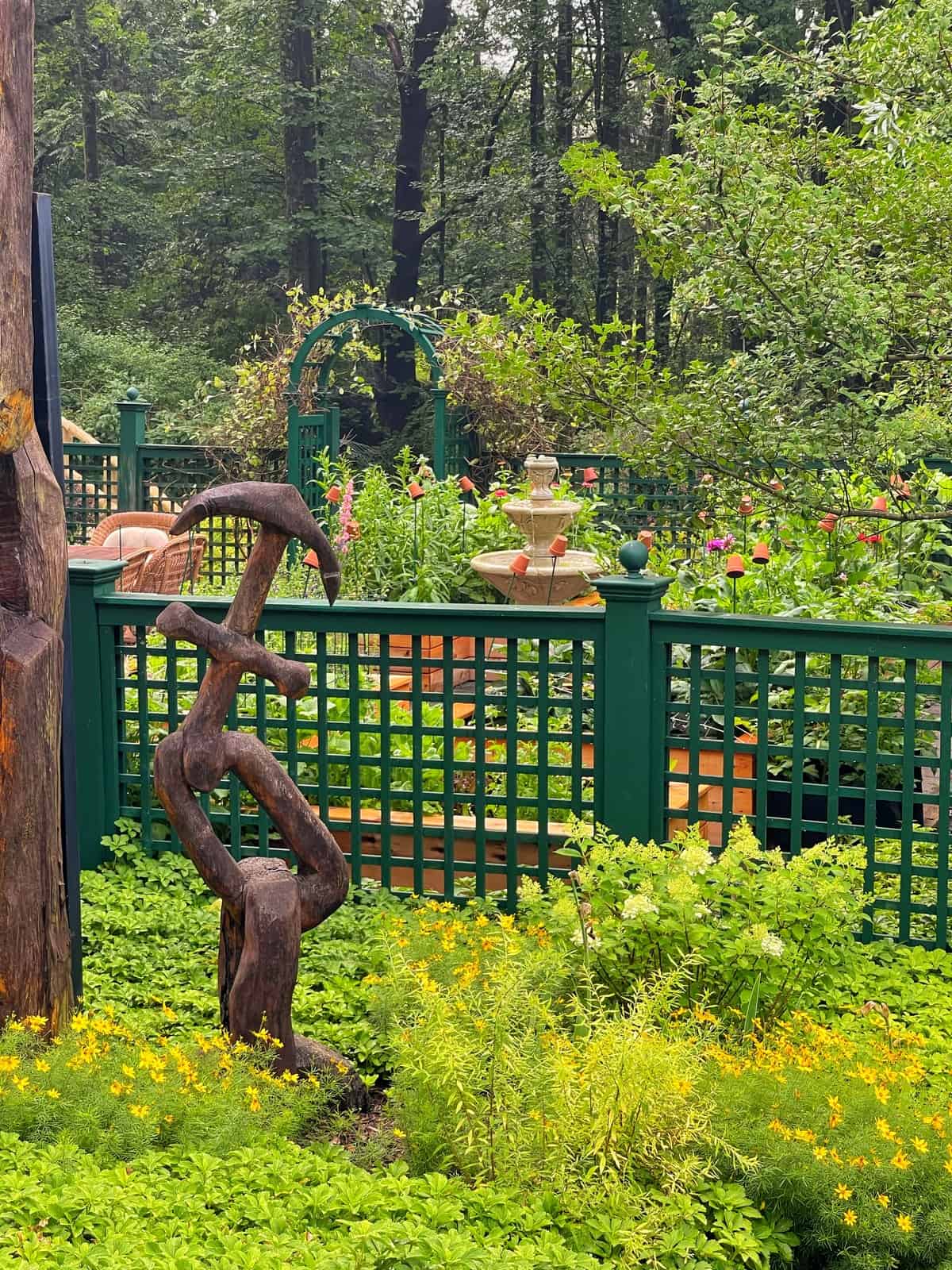
Pathways: Guiding the Eye and the Gardener
Pathways are essential for accessibility, defining beds, and adding to the overall visual design. They invite you to stroll through your garden, appreciating its every detail.
- Materials: Choose materials that complement your home’s style, such as crushed gravel, natural stone, brick, or even wood chips.
- Functionality: Ensure your main paths are wide enough (ideally 30-36 inches) to comfortably accommodate a wheelbarrow, making maintenance and harvesting a breeze. Smaller access paths between beds can be narrower.
Embrace Geometric Patterns
While not strictly necessary for every potager, geometric patterns are a hallmark of formal French designs, adding elegance and order.
- Formal: Consider using symmetrical designs like squares, rectangles, circles, or even intricate parterre patterns defined by pathways or low hedging. These create striking visual impact.
- Informal: Even in a more relaxed potager, clearly defined beds (whether rectangular, curving, or organic in shape) will bring a sense of intention and tidiness.

Raised Beds vs. In-Ground: Your Choice of Canvas
Both options have their merits for a potager:
Raised Beds
- Pros: Excellent drainage, warmer soil earlier in spring, easier access for planting and harvesting (especially for those with mobility concerns), and superb for defining geometric shapes and creating a tidy appearance. You have complete control over soil quality.
- Cons: Initial cost and labor for construction, can dry out faster than in-ground beds, and may require more frequent watering.
In-Ground
- Pros: Lower initial cost, often less prone to drying out, and can blend more seamlessly into a natural landscape.
- Cons: Can be harder to define distinct beds aesthetically, may require more intensive soil improvement if your existing soil is poor, and can be less accessible.
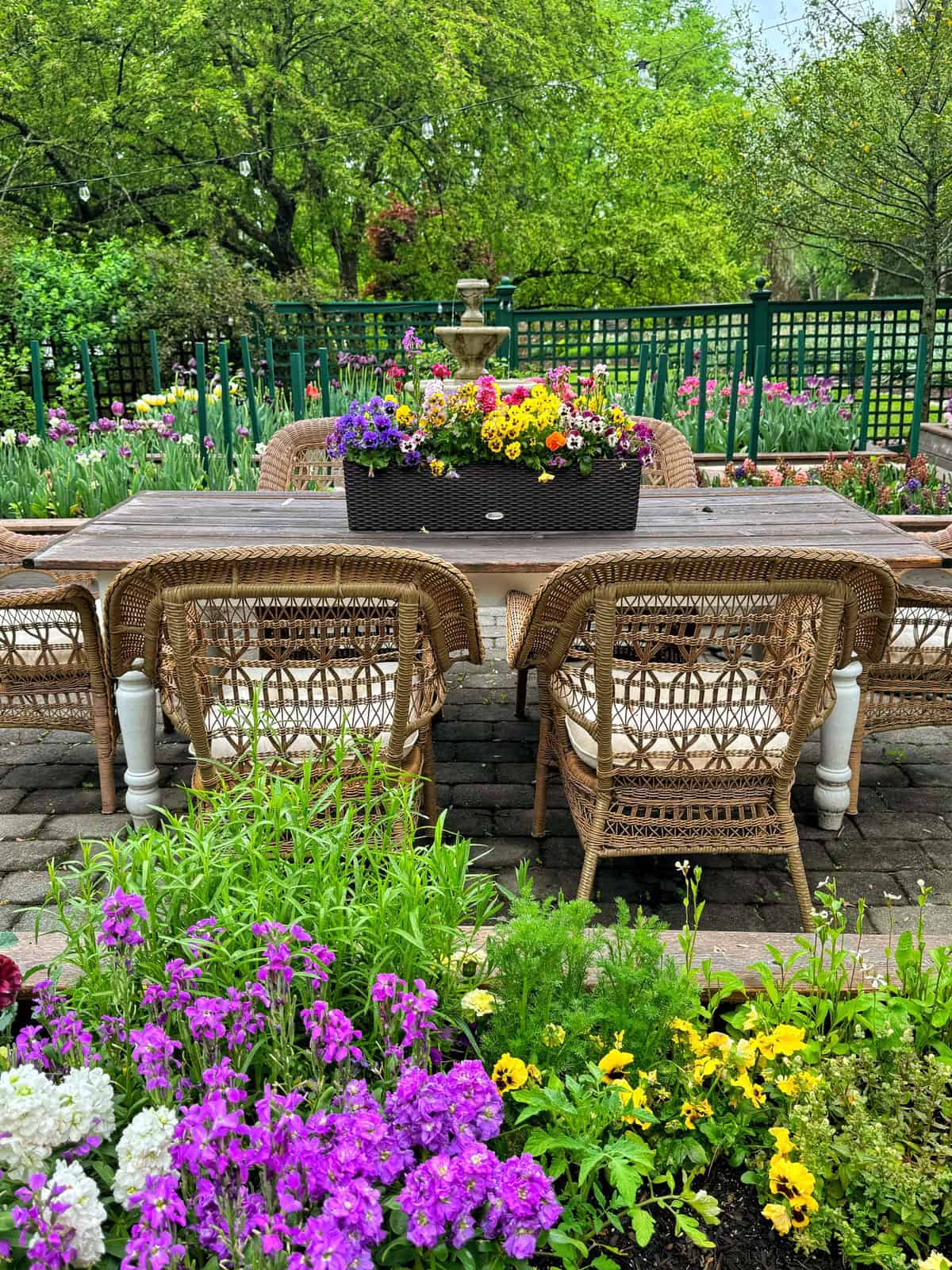
2. Weaving the Tapestry: Aesthetics and Planting Kitchen Garden Design
This is where your potager truly comes alive, transforming simple plants into a cohesive and captivating display.
Play with Color, Texture, and Form
Think like an artist, arranging plants to create visual interest.
- Color: Create striking contrasts or harmonious blends. Imagine the deep purple of ‘Red Acre’ cabbage next to the vibrant green of ‘Bright Lights’ Swiss chard, or the sunny yellow of calendula interspersed with feathery carrot tops and bright green lettuces.
- Texture: Pair broad, bold leaves of kale or squash with the delicate, lacy foliage of carrots, dill, or fennel. Introduce architectural elements like the spiky leaves of an artichoke.
- Form: Mix upright, columnar plants (like staked tomatoes or corn) with vining plants that can sprawl or climb (cucumbers, beans, squashes) and low-growing groundcovers like fragrant thyme or prostrate rosemary. This creates a dynamic, multi-layered look.

Create Captivating Focal Points:
A well-placed focal point draws the eye and provides a sense of destination within your garden. Consider:
- An elegant obelisk for climbing beans or gourds.
- A serene birdbath or a small, bubbling fountain.
- A charming statue or piece of garden art.
- A particularly striking plant, like a mature, majestic artichoke plant or a beautifully trained standard rose (which can also be edible!).
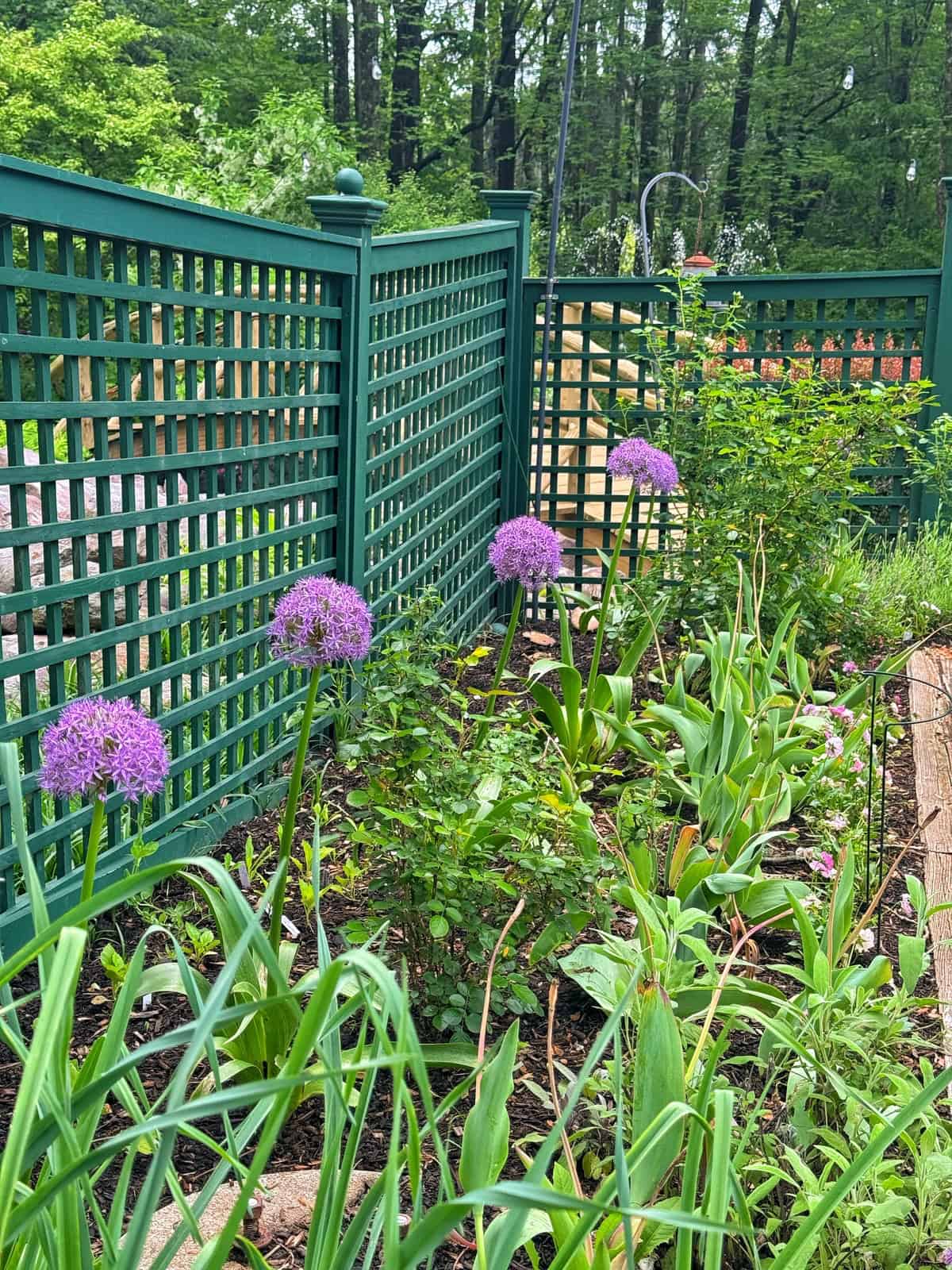
Go Vertical: Maximize Space and Drama
Don’t forget to look up! Vertical elements add dimension, maximize growing space, and create an impressive display.
- Utilize trellises, arbors, pergolas, or obelisks for climbing plants like pole beans, peas, cucumbers, gourds, or even vining squashes.
- Consider espaliered fruit trees (like apples or pears) trained flat against a wall or fence – they’re both productive and incredibly beautiful.
Repetition for Rhythm and Cohesion
Repeating certain plants, colors, or structural elements throughout your garden creates a sense of rhythm and visual unity. This can be as simple as:
- Using the same type of edging around all your beds.
- Planting clumps of the same herb (e.g., parsley) at key intersections.
- Repeating a specific flower color (e.g., splashes of yellow calendula) throughout different beds. Repetition makes the overall design feel intentional and harmonious.
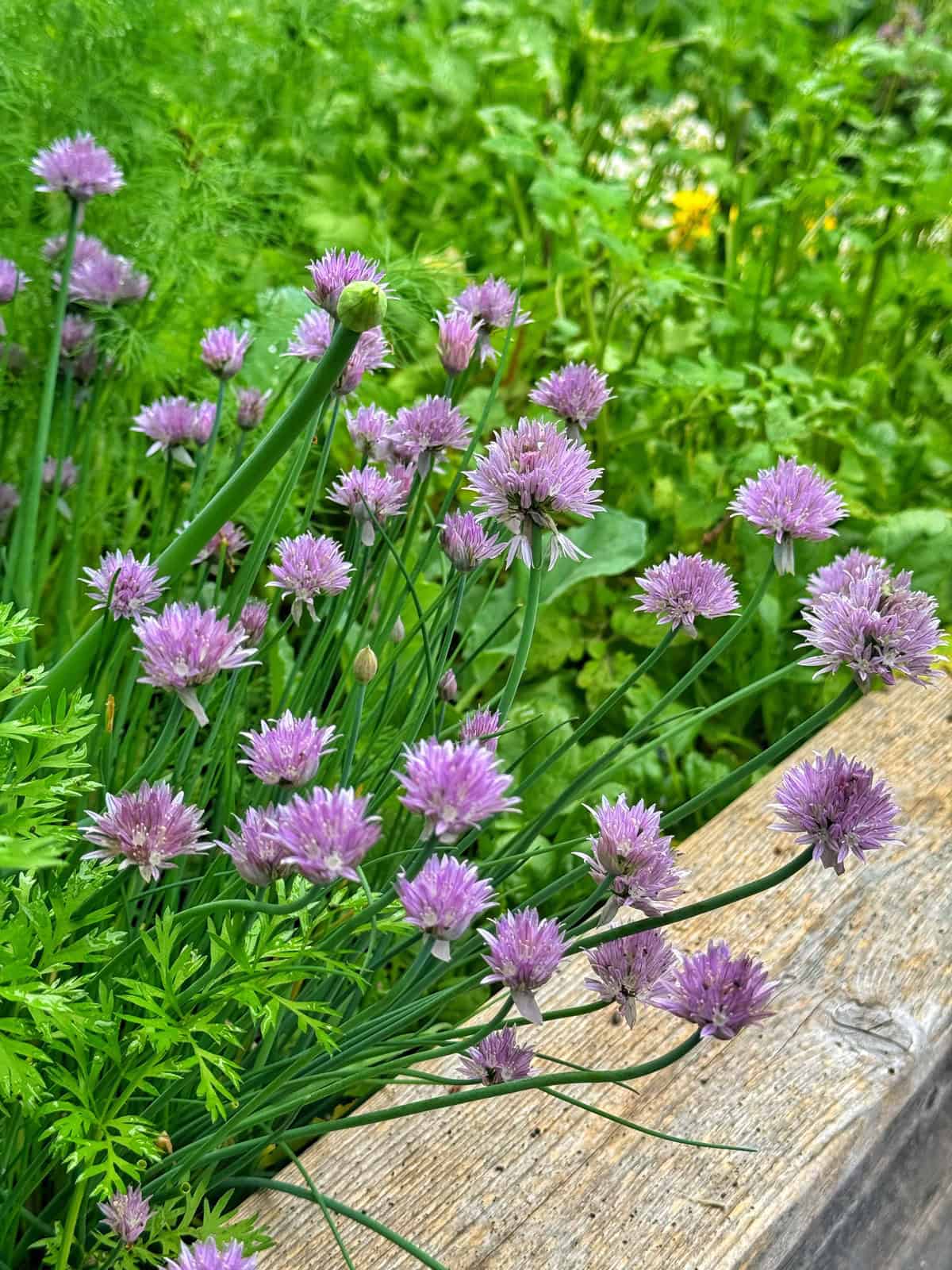
3. Choosing Your Stars: Plant Selection for a Potager
Moving beyond simply “mixing flowers and veggies,” successful potager plant selection focuses on varieties that offer both aesthetic appeal and culinary delight, often with beneficial interactions.
Emphasize Continuous Harvest
To ensure your potager remains productive and visually appealing throughout the seasons, plan for succession planting. As one crop finishes (like radishes or early lettuce), plant something new in its place (e.g., bush beans, another round of lettuce, or fall greens). This strategy maintains a constant rotation of fresh food and keeps your garden looking vibrant and full, rather than sparse after a summer harvest.
Ornamental Edibles: The Triple Threat
These plants are beautiful, delicious, and often easy to grow.
- Vibrant Greens: Rainbow chard, ‘Red Russian’ kale, ‘Bright Lights’ Swiss chard, ‘Black Magic’ kale, ‘Red Leaf’ lettuce, ‘Flashy Trout Back’ romaine.
- Colorful Herbs: Purple basil, variegated sage, tricolor sage.
- Eye-Catching Vegetables: Artichokes (stunning architectural plants), ‘Purple Flash’ ornamental peppers, ‘Romanesco’ broccoli (beautiful spiral form), ‘Chioggia’ beets (striking internal rings).

Beneficial Blooms: More Than Just Pretty Faces
Flowers in a potager do double duty.
- Pest Deterrents: Marigolds (various types deter nematodes and other pests), nasturtiums (can act as a trap crop for aphids, plus their leaves and flowers are edible!).
- Pollinator Attractors: Calendula (edible petals, attracts pollinators), borage (attracts bees, can deter tomato hornworms), cosmos, zinnias, sunflowers (for height and seeds).
- Edible Flowers: Many of the above also have edible petals, adding a gourmet touch to your dishes.
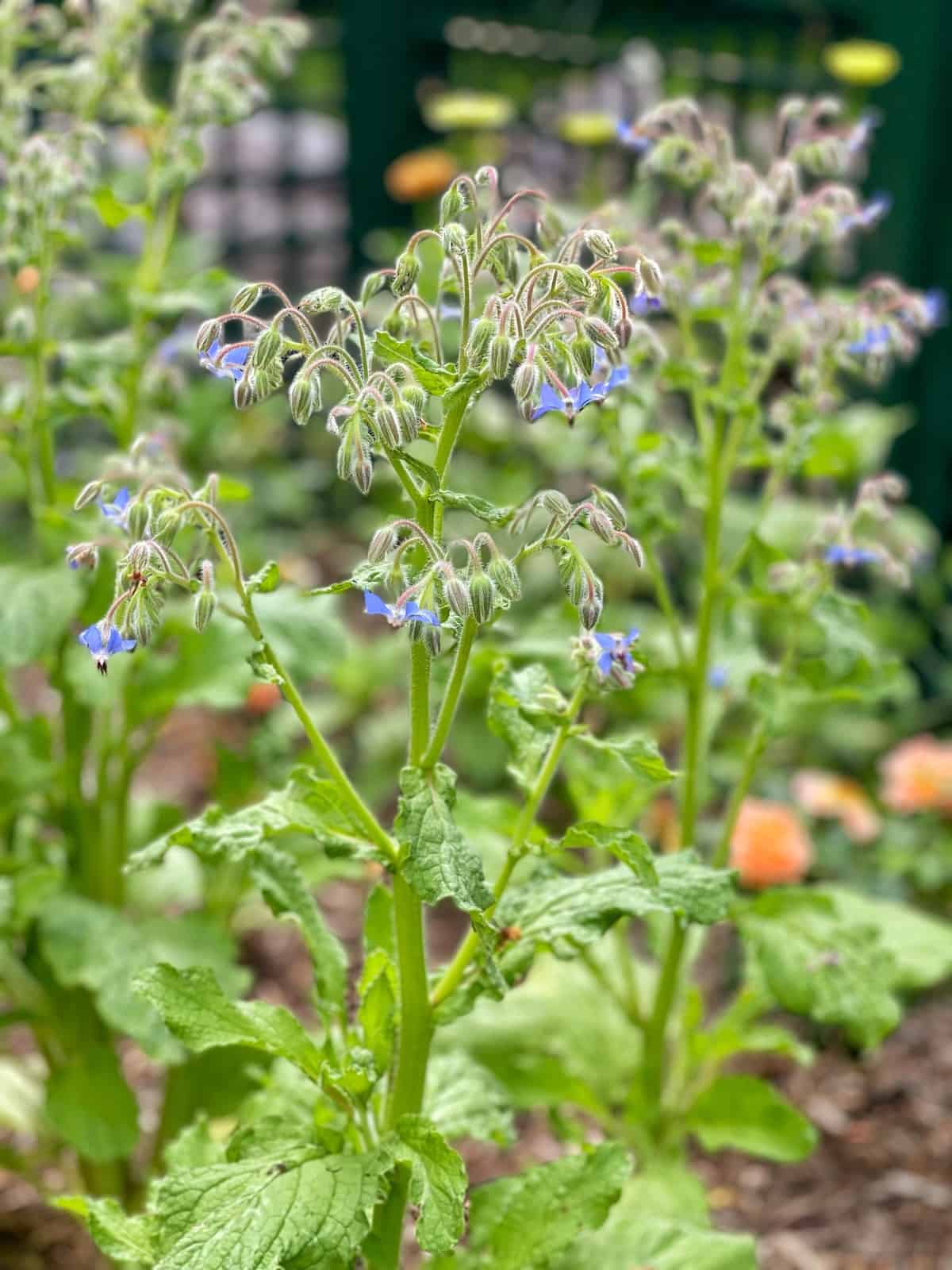
Herbs for Structure and Scent
Herbs are indispensable for their fragrance, culinary uses, and often, their structural contribution.
- Edging: Lavender (fragrant, attracts pollinators), dwarf rosemary, thyme.
- Structure: Upright rosemary (can be pruned into small hedges), shrubby sage.
- Groundcover: Creeping thyme.
Small Fruits: Delicious Accents
Integrate berries and small fruits for added charm and snacks.
- Edging/Groundcover: Alpine or June-bearing strawberries (can be tucked along pathways or at the front of beds).
- Bush Berries: Dwarf varieties of currants, blueberries, or gooseberries (if space allows) can add structure and delicious fruit.
- Dwarf Fruit Trees: Consider dwarf apple or pear trees trained as espaliers or grown in large containers.

Potager Garden Planting Guides
Seasonal Planting Guides For Your Potager Garden
Understanding the optimal planting times for various crops is crucial for a successful potager garden. Because not everything gets planted all at once. Here are general guidelines for different seasons:
Spring
- Early Spring (March – April): Plant cool-season crops like peas, lettuce, spinach, radishes, and broccoli. These vegetables thrive in cooler temperatures and can withstand light frosts.
- Late Spring (May – June): Transition to warm-season crops such as tomatoes, peppers, cucumbers, squash, and beans as the soil warms up and the risk of frost diminishes
Summer
Summer (June – August): Continue planting warm-season crops. This is also a good time to plant fast-growing crops like basil, cilantro, and summer squashes. Keep an eye on watering needs as temperatures rise.
Fall
- Early Fall (September – October): Plant cool-season crops again, such as kale, Brussels sprouts, and turnips. These crops can handle the cooler temperatures and will mature in the fall.
- Late Fall (November): Depending on your region, consider planting garlic and cover crops to improve soil health over winter.
Winter
Winter (December – February): In mild climates, continue growing hardy greens like spinach and Swiss chard under row covers or in cold frames. Start planning for the next growing season and prepare soil as weather permits.
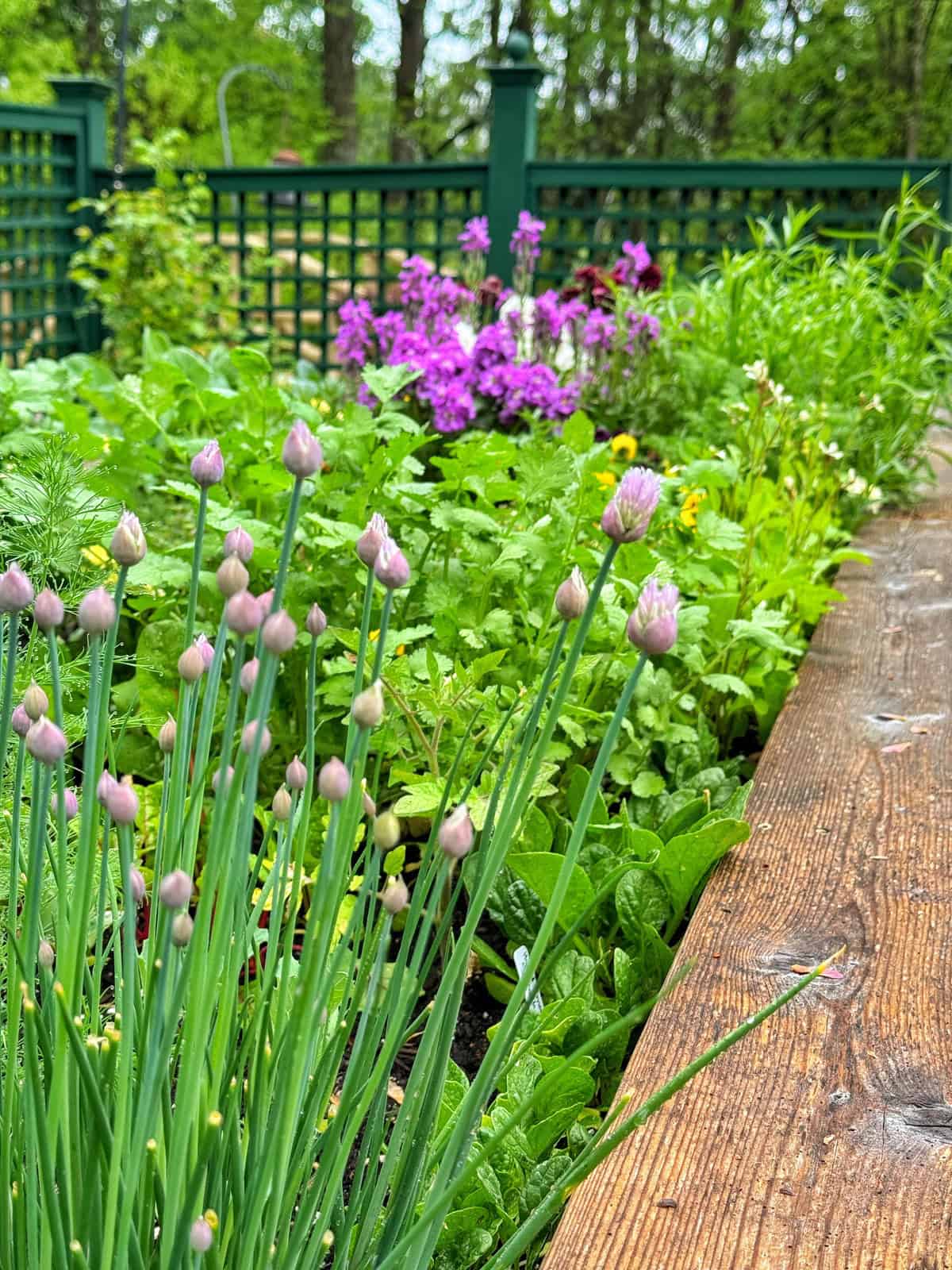
Companion Plant Recommendations
Beyond their aesthetic appeal, integrating flowers and herbs into your potager offers a secret weapon for a healthier, more productive garden: companion planting. This ancient practice involves strategically placing certain plants together because they benefit each other in various ways – deterring pests, attracting beneficial insects, improving soil health, or even enhancing flavor!
- Tomatoes and Basil: Planting basil near tomatoes can improve tomato flavor and help deter pests.
- Carrots and Radishes: Radishes grow quickly and can be harvested before carrots need the space, making them good companions for efficient use of garden space.
- Beans and Corn: Beans can climb the corn stalks, saving space and benefiting from the corn’s height.
- Cucumbers and Nasturtiums: Nasturtiums attract pollinators and can repel cucumber beetles, protecting your cucumbers
- Garlic: a natural pest deterrent for your kitchen garden.
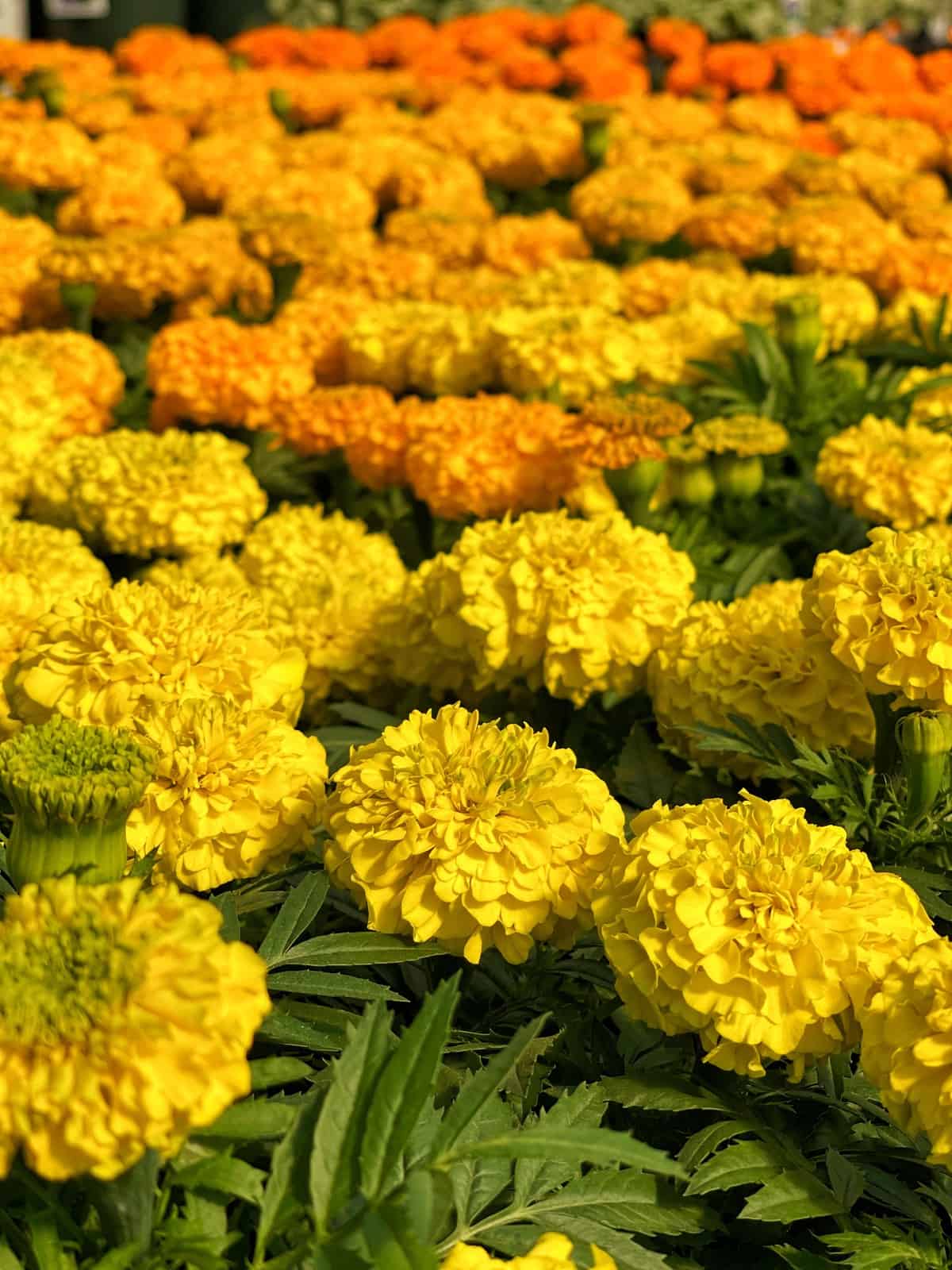
Planting companions really makes a difference when growing vegetables. So don’t overlook this part as it will help reduce the use of pesticides too.
- Marigolds: Plant marigolds throughout the garden to repel nematodes and other pests.
- Chives and Carrots: Chives can help deter carrot flies, making them a beneficial companion to carrots.
- Squash and Beans: Beans fix nitrogen in the soil, which benefits heavy feeders like squash
To learn more about companion planting, read this post here.
Succession Planting in Your Kitchen Garden
Implement succession planting to ensure a continuous harvest throughout the growing season. For instance, after harvesting early spring crops like radishes, replant the area with summer crops like bush beans. This approach maximizes the productivity of your garden space over time.

Maintaining Your Potager Garden
To keep your potager garden flourishing, a little maintenance goes a long way. Here’s what you need to know!
Weeding Your Edible Landscape
Keep the area around your potager garden weed-free to minimize competition for nutrients and water. Regular weeding also helps prevent the spread of pests and diseases. I love to use this hand weeding tool that gets around my pot marigold flowers with ease and removes them from the root with great accuracy.
Watering Tips for a Thriving Potager Garden
Consistent watering is essential for the health of your potager garden. Most vegetables require about 1-1.5 inches of water per week, either from rainfall or supplemental irrigation. Watering early in the morning is ideal, as it reduces evaporation and allows plants to dry off during the day, minimizing the risk of disease.
Use drip irrigation or soaker hoses to deliver water directly to the soil and roots, which conserves water and reduces foliar diseases How much you water will depend on the weather in your climate.
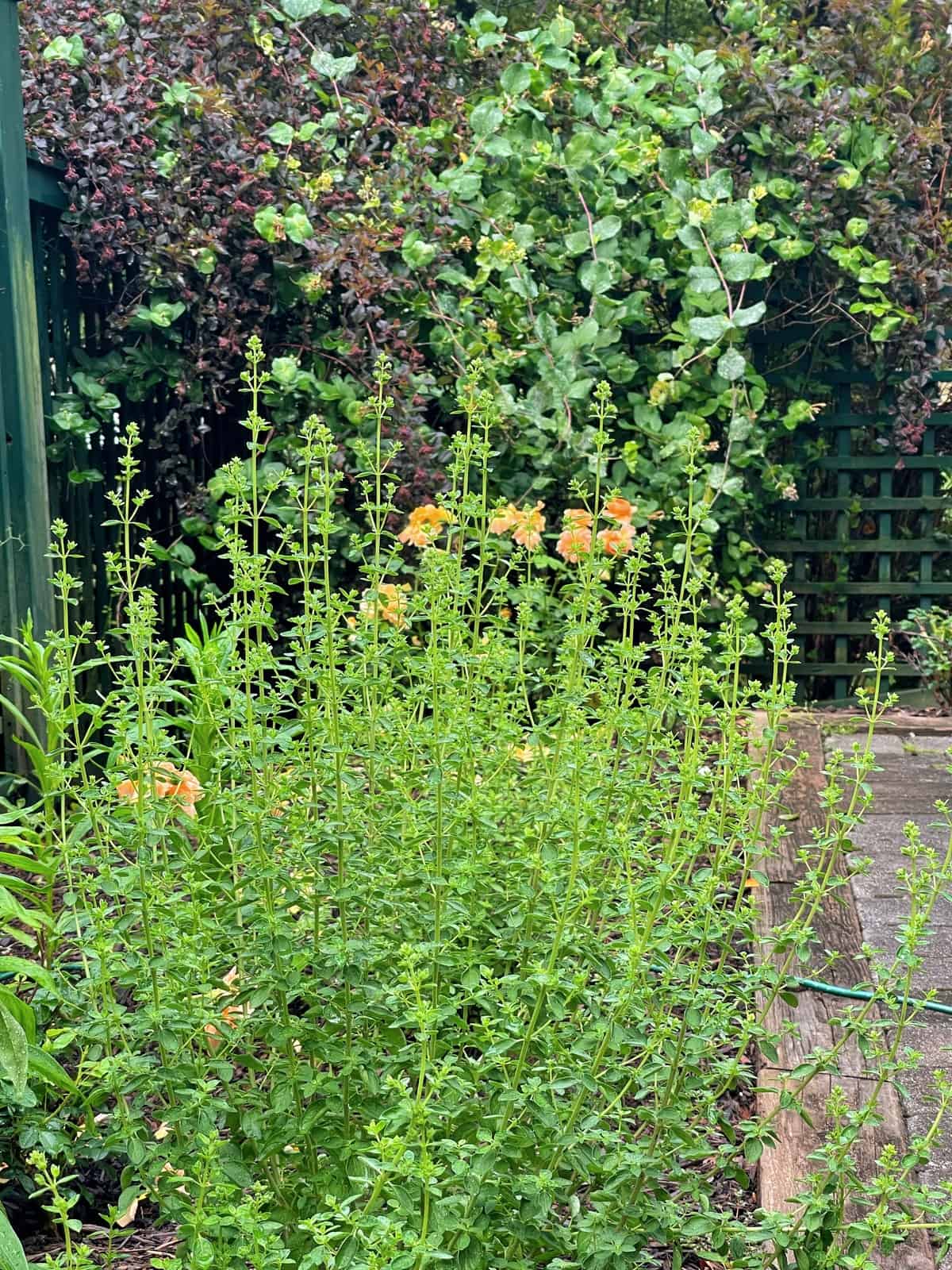
Mulching a Potager Garden
Mulch the beds to retain soil moisture, suppress weeds, and improve soil structure. Ensure your garden has a reliable water source, especially during dry periods. Organic mulches, such as straw, compost, or shredded leaves, are beneficial as they decompose and enrich the soil. Mulching also helps prevent soil erosion and reduces water runoff. Consider planting cover crops like clover or rye in the off-season to enrich the soil and prevent erosion
Fertilizing Your Potager Garden
Amend the soil with compost, leaf mold, and other organic matter. Use organic fertilizers that feed your vegetables and herbs like fish emulsion. Fertilize according to the needs of different plants, typically during the growing season to support healthy growth and fruiting
Use natural fertilizers like compost, aged manure, bone meal, and fish emulsion to provide essential nutrients to plants without harming the environment. These fertilizers release nutrients slowly, promoting steady plant growth and reducing the risk of nutrient runoff into waterways
Pruning and Supporting Plants in Your Kitchen Garden
Regularly prune and train plants to improve air circulation, reduce disease risk, and promote better fruit production. For instance, prune tomato plants to remove suckers and improve airflow. Use stakes, cages, or trellises to support climbing plants and keep them off the ground, which helps reduce pest and disease problems

Pest and Disease Management
Monitor your garden regularly for signs of pests and diseases. Use integrated pest management (IPM) techniques, such as introducing beneficial insects, using row covers, and practicing crop rotation. Remove and destroy any infected plant material to prevent the spread of disease. Companion planting can also help deter pests and promote a healthy garden ecosystem. Stay vigilant for any signs of pests or diseases and take necessary measures to keep them at bay.
Harvesting Crops from Your Potager Garden
As your potager garden matures, the time will come to reap the rewards of your hard work and dedication. Harvest vegetables when they’re at their peak, cut those vibrant flowers to brighten up your home with arrangements, and savor the delicious flavors of your garden-to-table meals. Share your bounty with friends and neighbors or indulge in the joy of giving back to nature by composting any plant waste.
Composting in Your Kitchen Garden
Maintain a compost pile to recycle garden waste into valuable organic matter. Composting not only reduces garden waste but also provides a rich, nutrient-dense amendment for your soil. Turn the compost regularly to aerate it and speed up the decomposition process.
Seasonal Maintenance
Adjust your maintenance routine according to the season. In spring, focus on planting and soil preparation. Summer requires vigilant watering, weeding, and pest control. Fall is the time for harvesting and preparing the garden for winter, including mulching and planting cover crops. Winter involves minimal maintenance but is a good time for planning and preparing for the next growing season

Addressing Common Challenges & Considerations in Your Potager
Even the most beautiful potager requires a little planning and problem-solving. Here are some common challenges you might encounter and how to address them, ensuring your garden remains a source of joy and abundance.
Space Limitations: Think Creatively!
Don’t let a small footprint deter you from creating a stunning potager.
- Container Potagers: For balconies, patios, or even sunny windowsills, containers are your best friends! Opt for larger pots that offer more soil volume for healthier roots. Mix and match edible plants with vibrant flowers in a single container for a miniature potager display. Think about growing compact varieties of tomatoes, bush beans, herbs, and colorful greens like Swiss chard or ‘Bright Lights’ lettuce.
- Vertical Gardening: Maximize every inch by growing upwards! Trellises, obelisks, and arbors are not just beautiful structural elements; they’re essential for vining plants like cucumbers, pole beans, and even some squash varieties. Wall-mounted planters and vertical garden systems can transform a blank wall into a productive, living tapestry.
Time Commitment: An Investment in Beauty and Bounty
It’s true that a potager, with its emphasis on aesthetics and diverse plantings, often requires more intentional design and ongoing care than a simple row garden. However, the rewards are truly significant!
- Design for Efficiency: Thoughtful planning can minimize future work. Consider accessible pathways, efficient watering systems (like drip irrigation), and choosing plants that thrive in your climate.
- Enjoy the Process: View maintenance as an opportunity to connect with nature, observe your plants, and harvest fresh ingredients. It’s a therapeutic and rewarding experience, not just a chore. The fresh flavors and beautiful surroundings make every minute worthwhile.
Starting Small: A Gentle Beginning
For beginners, or anyone feeling overwhelmed, the best advice is to start small.
- Focus on Favorites: Choose a few herbs, vegetables, or flowers that you love to eat or admire. Success with a small selection will inspire you to expand in future seasons. Remember, a thriving small potager is far more rewarding than an ambitious, neglected one.
- Begin with a Section: Designate a small section of your yard or a few raised beds for your initial potager. This allows you to learn the ropes, understand your local conditions, and gain confidence without feeling overwhelmed.

More Sustainable Gardening Practices to Employ
Implementing sustainable gardening practices in your potager garden ensures long-term health and productivity while minimizing environmental impact. These practices focus on enhancing soil health, conserving water, managing pests naturally, and promoting biodiversity. Here are some essential sustainable gardening practices to incorporate as you grow your kitchen garden.
Organic Soil Management
Building and maintaining healthy soil is the cornerstone of sustainable gardening. Use lots of organic matter such as compost, aged manure, and green manure to enrich the soil. These materials improve soil structure, enhance water retention, and provide essential nutrients to plants. Avoid synthetic fertilizers, which can degrade soil health over time and contribute to pollution.
Water Conservation
Efficient water use is critical in sustainable gardening. Implementing drip irrigation or soaker hoses delivers water directly to the plant roots, minimizing evaporation and runoff. Mulching helps retain soil moisture, reducing the need for frequent watering. Collecting rainwater in barrels for garden use is another excellent way to conserve water.
Integrated Pest Management (IPM)
IPM combines biological, cultural, physical, and chemical tools to manage pests in an environmentally and economically sustainable way. Encourage beneficial insects such as ladybugs and predatory beetles that naturally control pest populations. Use physical barriers like row covers to protect plants from pests. Practice crop rotation and plant disease-resistant varieties to reduce pest pressure.
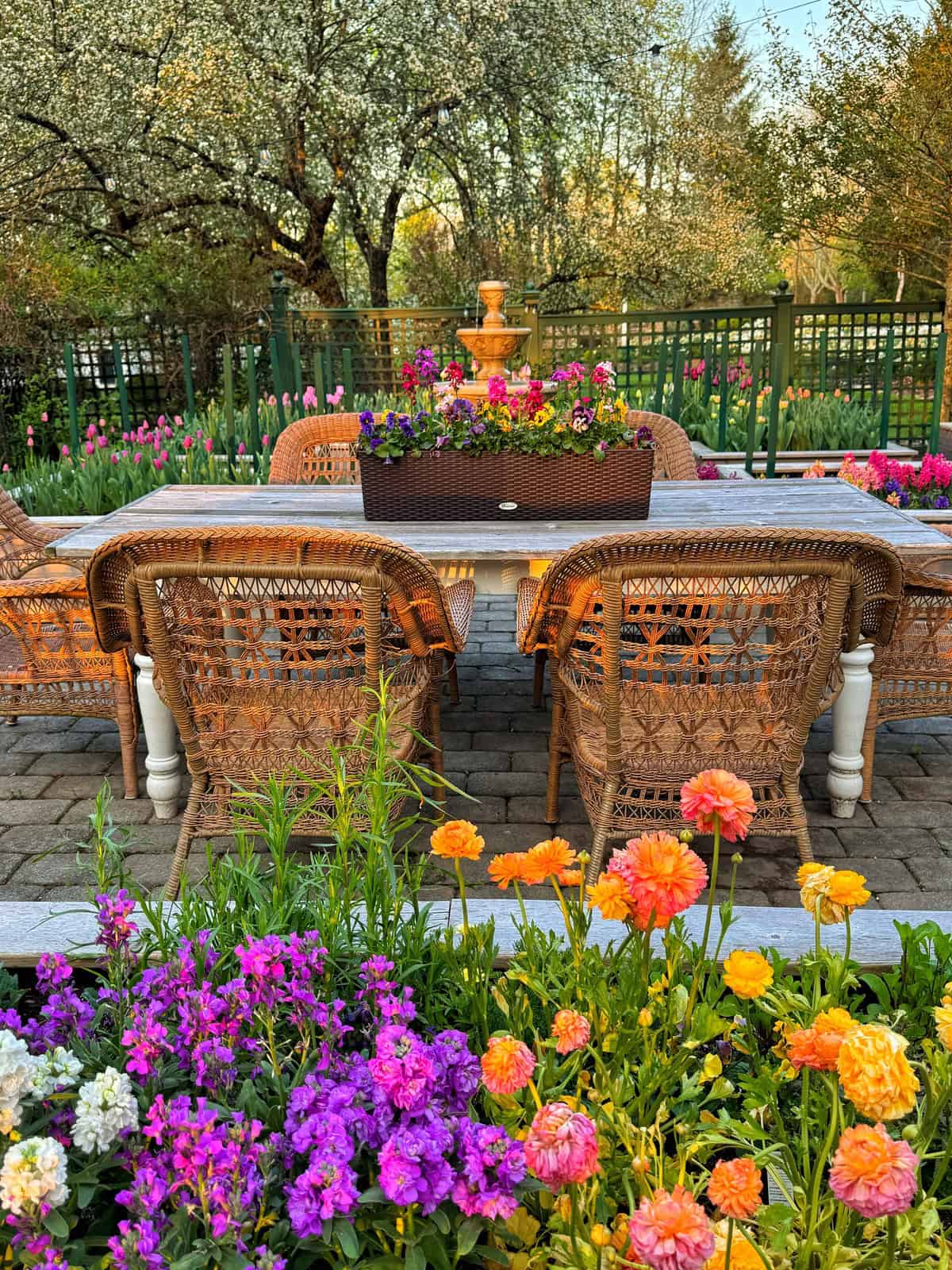
Crop Rotation
Rotating crops helps prevent the buildup of soil-borne diseases and pests, as different plants have different nutrient needs and attract different pests. For example, follow heavy feeders like tomatoes with legumes that fix nitrogen in the soil. Crop rotation also helps maintain soil fertility and structure.
Cover Crops
Planting cover crops such as clover, rye, or vetch during the off-season protects and improves the soil. Cover crops prevent erosion, suppress weeds, and add organic matter to the soil when turned under. They also improve soil structure and fertility by fixing nitrogen and adding biomass.
Biodiversity
Plant a diverse range of crops to create a resilient garden ecosystem. Biodiversity helps reduce pest and disease outbreaks by providing habitats for beneficial insects and other wildlife. Include a variety of vegetables, herbs, flowers, and fruiting plants to attract pollinators and natural pest predators.
Reducing Chemical Use
Minimize the use of synthetic pesticides and herbicides. Instead, opt for organic or natural alternatives, such as neem oil, insecticidal soap, and diatomaceous earth. These options are less harmful to beneficial insects, wildlife, and the environment


About My Potager Garden: A Journey of Growth and Discovery
When we moved into our new home a few years ago, the old basketball court quickly revealed itself as the prime location for a thriving garden. It’s one of the few open, sunny spots in our yard that offers excellent protection from critters like deer, making it perfect for cultivating vegetables, herbs, and flowers. Over the past few years, this space has truly transformed into the heart of my outdoor life.
Designing Our Potager: From Blueprint to Abundance
My husband, Chris, initially designed the shape of our raised garden beds in a beautiful geometric pattern, intending to incorporate a large fountain as a central focal point. He even had ambitious plans for a large, U-shaped bed with a sweeping curve. While his initial vision was grand, we opted to square off the design of the five raised beds so I could get planting sooner. And I’m so glad we did! This decision allowed me to dive right in and start learning the unique light conditions and growth patterns of this specific space.
Having had a few seasons now, I’ve really taken my time to understand how everything thrives here. The potager has continued to evolve organically. We’ve incorporated more vertical elements like arches and obelisks, which not only maximize our growing space but also add a beautiful aesthetic layer to the design.
Because our potager is quite a large and open area, we decided to incorporate an outdoor dining space directly within the garden. It’s truly wonderful to sit here, surrounded by all the plants, and enjoy a meal. We even have dreams of adding an outdoor kitchen in the future to fully embrace that farm-to-table experience.
The fountain we added a while back has become one of my favorite features. There’s something incredibly soothing about the sound of trickling water while I’m cutting flowers, weeding, or simply enjoying a quiet moment in this vibrant space.
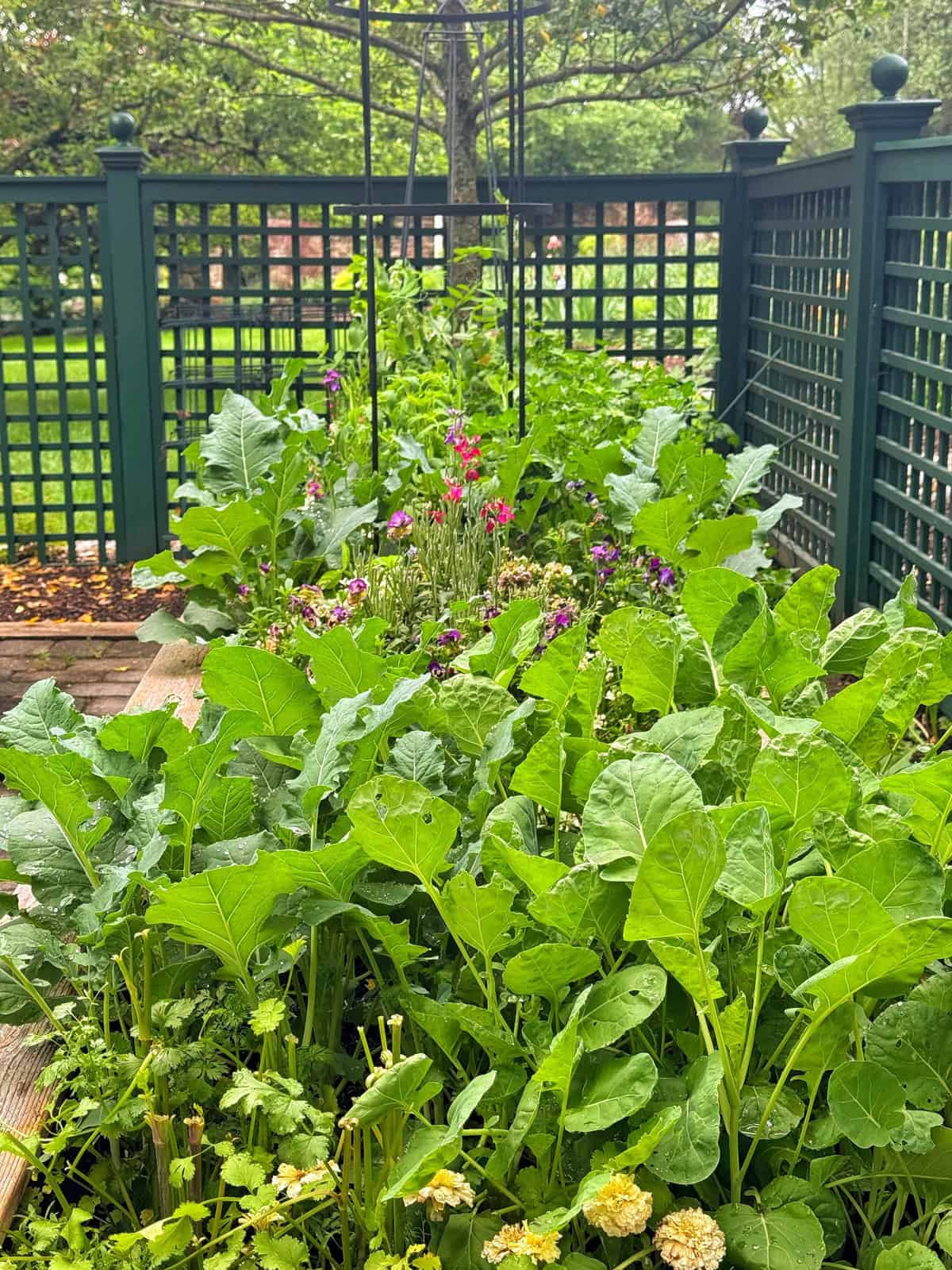
Building Our DIY Raised Beds
Chris and his friend built the five raised garden beds for me back in March of 2023. To give our plants the best possible start, we filled them with a rich blend of leaf mold, compost, and high-quality raised garden bed soil. This foundation has been key to the health and vigor of everything we’ve grown.
Cultivating My Potager Garden: Kitchen & Cut Flowers
Over the past few seasons, my potager has become a true reflection of my passion for both kitchen gardening and cut flower cultivation. I’ve loved the process of starting seeds indoors and using the winter sowing method to propagate a wide variety of plants for both my edible and ornamental beds.
Across the five raised beds, two are primarily dedicated to a rotating bounty of edibles like tomatoes, peppers, celery, lettuce, cucumbers, various herbs, and strawberries. I’ve also expanded beyond the raised beds, tucking in onions, eggplant, zucchini, and summer squash in the surrounding in-ground areas. For a fun experiment, I’ve been growing potatoes in grow bags, which has been a fascinating process! I also planted garlic in the fall for the first time in this garden and look forward to adding blueberry plants soon. Having grown raspberries and blueberries in my previous garden, I truly miss harvesting them, and thankfully, New Jersey’s climate is perfect for them.
In addition to our delicious edibles, my potager overflows with a stunning array of flowers that I’ve grown from seed or sourced from local growers and nurseries. It’s a joy to be able to step out and gather fresh blooms for bouquets. My current favorites include:
- dahlias
- zinnias
- snapdragons
- larkspur
- strawflowers
- sunflowers
- calendula
- tithonia
- sweet peas
- borage
- roses
- marigolds


Final Thoughts on Growing a Potager Garden
Creating a potager garden offers a unique opportunity to blend beauty with functionality, producing fresh, organic food while enhancing the aesthetic appeal of your landscape. By carefully planning your garden, selecting diverse and complementary plants, and implementing sustainable gardening practices, you can cultivate a thriving and visually stunning garden space.
Embrace the principles of organic soil management, water conservation, and biodiversity to ensure your garden remains healthy and productive year after year. Regular maintenance, including proper watering, mulching, and pest management, will keep your potager garden flourishing throughout the seasons.
Ultimately, a well-designed potager garden not only provides delicious, homegrown produce but also supports a healthier environment and a more sustainable way of living. Enjoy the process of planning, planting, and nurturing your garden, and take pride in the beautiful, functional, and eco-friendly space you create.
Happy gardening!

For more information, read these university extension articles from Clemson Cooperative Extension and MU Extension.
To drill down on more beginner gardening techniques and tips, please read these posts:
- Flower Gardening 101
- Growing a Cut Flower Garden for Beginners
- Container Garden Ideas for Beginners
- How to Start a Vegetable Garden
- Herb Gardening for Beginners
If you have any questions, comments or suggestions, please let me know in the comments below. I’d love to hear! And feel free to share this post with anyone you think would find it helpful too.
Thank you for visiting the blog today!
Enjoy your day! xo











